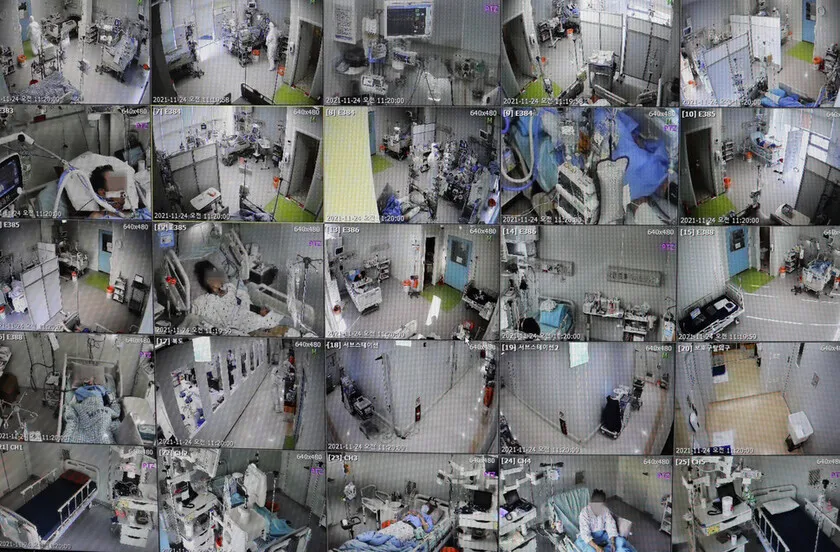hankyoreh
Links to other country sites 다른 나라 사이트 링크
With COVID-19 cases on the rise, S. Korea sees record critical cases, deaths

A month after South Korea began relaxing COVID-19 prevention measures as part of a gradual return to everyday life, deaths and severe or critical cases are at an all-time high, while the COVID-19 critical care hospital bed occupancy rate has surpassed 75% nationally for the first time.
This is the first time the situation has exceeded the criteria announced by the government for an emergency assessment, with the possibility of instituting an “emergency plan.”
The Central Disease Control Headquarters (CDCH) announced Sunday that a total of 3,928 new COVID-19 cases had been confirmed as of the end of the day Saturday.
While the number was 140 lower than the 4,068 counted on Friday, it was the highest total to be announced on a Sunday since the pandemic began. A total of 647 patients were listed as being in severe or critical condition, and an additional 56 deaths were tallied — both all-time high numbers.
The burden on the healthcare system has also been growing. The nationwide COVID-19 critical care hospital bed occupancy rate stood at 75.04%, with patients occupying 866 out of 1,154 available beds.
The pressure on hospitals has been compounded with nearly two weeks of caseloads coming in at around 2,000 per day — primarily in the greater Seoul area that includes Seoul, Incheon and Gyeonggi Province — and the number of severe and critical cases far exceeding the 500-case limit named by the South Korean government as a level it could “stably manage.”
The government has reacted with measures that include relocating patients in greater Seoul to other regions when possible, but that spillover effect has ended up driving up hospital bed occupancy rates outside of the capital region.
As of 5 pm Saturday, critical care bed occupancy rates stood at 86.09% for Seoul, 83.54% for Incheon, and 83.33% for Gyeonggi Province. But some regions outside the greater Seoul area had even higher occupancy rates, including Daejeon at 96%, North Chungcheong Province at 90.63%, and South Chungcheong Province at 89.47%.
Laying out its new standards for COVID-19 risk assessment on Nov. 17 in the wake of the transition toward a “gradual return to everyday life,” the government listed criteria for implementing an “emergency assessment” to discuss the possibility of imposing an emergency plan or other measures.
The criteria included a nationwide critical care bed occupancy rate of 75% or more; a weekly assessment identifying the risk level as “very high”; a four-week recovery stage assessment showing a risk level of “high” or “very high”; and a scenario in which the CDCH and Central Disaster Management Headquarters deem consideration of an emergency plan to be necessary based on opinions of experts on the disease control and healthcare subcommittee.
With record-high numbers of severe/critical cases and deaths for days in a row casting a pall on the transition toward “living with COVID-19,” the government held a meeting of the Committee for Recovery of Normal Life from COVID-19’s disease control and healthcare subcommittee on Sunday afternoon to discuss an assessment of the current risks.
While there were plans for an announcement Monday afternoon of comprehensive response measures to the virus’ spread, the South Korean government has voiced its opposition to an emergency plan that would involve suspending the return to normalcy. Instead, it is examining approaches including extending vaccine passport requirements to teenagers and requiring renewal of passports after a booster shot as part of a more stringent disease control response.
Healthcare professionals said disease control capacities are effectively maxed out at the moment, stressing the urgent need for measures to reduce the new caseload.
“The limits on hospital bed availability mean that we’re going to need to reduce the number of severe cases, but even if we were to initiate an emergency plan right now, it would take another two weeks or so before it yields any effects,” said Eom Joong-sik, a professor of infectious disease at Gachon University Gil Medical Center.
“In the meantime, we’re going to keep seeing deaths,” he added.
By Lee Jae-ho and Kwon Ji-dam, staff reporters
Please direct questions or comments to [english@hani.co.kr]

Editorial・opinion
![[Column] Chaebol can’t take credit for KOSPI’s record rally [Column] Chaebol can’t take credit for KOSPI’s record rally](https://flexible.img.hani.co.kr/flexible/normal/500/300/imgdb/original/2025/1009/7717599742966572.jpg) [Column] Chaebol can’t take credit for KOSPI’s record rally
[Column] Chaebol can’t take credit for KOSPI’s record rally![[Column] Solving the dilemma of OPCON transfer and inter-Korean relations [Column] Solving the dilemma of OPCON transfer and inter-Korean relations](https://flexible.img.hani.co.kr/flexible/normal/500/300/imgdb/original/2025/1008/7017598865521297.jpg) [Column] Solving the dilemma of OPCON transfer and inter-Korean relations
[Column] Solving the dilemma of OPCON transfer and inter-Korean relations- [Column] Korea, don’t trust and don’t be fooled
- [Column] Understanding what the US means by ‘modernizing’ its alliance with Korea
- [Editorial] Judge’s conduct undermines confidence in Yoon’s insurrection trial
- [Editorial] Government negligence comes under scrutiny after Korean data center fire
- [Column] Trump at the UN: The braggadocio of evil
- [Editorial] Disruptions to government systems raises questions about Korea’s status as IT powerhouse
- [Column] There’s no compromising on ending the insurrection
- [Column] America is marching toward fascism
Most viewed articles
- 1What parallel visits to both Koreas by leaders of China, Russia may mean for NE Asia
- 2Will upcoming Korea summit allow Lee to get through to Trump on tariffs?
- 3From ‘kimbap’ to ‘maknae,’ Oxford English Dictionary sees explosion of Korean loanwords
- 4Takaichi’s rise raises concerns about stability of Seoul-Tokyo relations
- 5Special counsel seeks arrest of former justice minister on suspicion of aiding insurrection
- 6[Column] Hemedti, a true ‘hero’ of our time
- 7Women gather to protest biased investigations into hidden-camera incidents
- 8In a divided America, civic assemblies prove respectful debate is still possible
- 9[Column] Facing our fear of the “welfie” in “All of Us Are Dead”
- 10[Interview] Ensuring governments listen to proposals from the public a key piece of deliberative dem